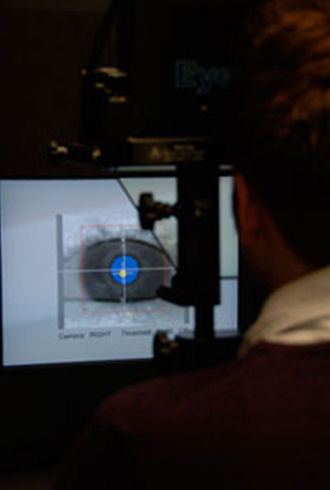| |
Assessment of visual function in ME/CFS
Investigator
Dr Claire Hutchinson
Institution
Vision and Language Research Group, College of Medicine, Biological Sciences and Psychology, University of Leicester, Leicester, UK
Funding
ME Research UK and the Irish ME Trust are providing joint funding for this novel study. |
|
 |
Background and aim
People with ME/CFS frequently report problems with their vision; in fact, around three-quarters of the 2,073 consecutive patients described in the Canadian review of 2003 specifically reported sensitivity to light and dullness of vision to be significant problems. Yet, there is very little formal evidence in the scientific literature that these symptoms exist, despite the fact they greatly affect quality of life and, moreover, can be easily measured.
As ME Research UK explained in a short essay in a recent issue of Breakthrough (Spring 2010, page 14), there were two reports in the scientific literature in the 1990s which reported ocular (eye) symptoms in people with ME/CFS. In one, a research group in Boston, Massachusetts (publishing in Optometry and Vision Science 1992) found that 24.7% of patients had reduced or stopped driving because of eye problems, compared with only 3% of controls. In the other report(Journal of the American Optometry Association 1994), all of the 25 consecutive CFS patients reported eye symptoms; the most common clinical findings were abnormalities of the pre-ocular tear film and ocular surface, reduced accommodation for age, and dry eyes. Then, from 2000 to 2010, two further reports appeared. The first was a case–control study (Annals of Ophthalmology 2000) in which 37 patients were found to have significant eye impairments compared with controls; the impairments included foggy/shadowed vision and sensitivity to light, and there were associated problems of eyeball movement (oculomotor impairments) or tear deficiency. The second study, from Russia (Vestnik Oftalmologii 2003), reported vascular pathology of the eye in 70.2% of patients.
The astounding thing is that these smallish observational studies represent almost the sum total of research into eye problems in ME/CFS in the past 30 years. And because no attempts have yet been made to quantify objectively the nature or extent of the visual symptoms in the illness, there remains no solid empirical evidence-base to back up the patients’ individual reports of disabling visual disturbances.
Therefore, the aim of this one-year pilot investigation is to determine quantitatively and objectively the nature and extent of the visual symptoms experienced by people with ME/CFS, determine their rate of occurrence, and establish whether the types and extent of visual symptoms experienced can be correlated with the severity of the condition and the specificity of other (non-visual) symptoms.
Based on the most commonly reported visual and vision-related symptoms reported by people with ME/CFS, Dr Hutchinson’s investigations will be primarily concerned with two main categories of visual impairment:
- heightened visual awareness, of which hypersensitivity to light and difficulty suppressing irrelevant background visual information are the main subjective visual symptoms;
- eye-movement problems, of which difficulty focusing on images or tracking objects are the major subjective visual symptoms.
Each of these aspects will be investigated in a series of specialist ophthalmic examinations used in the Vision and Language Research Laboratory.
For this initial study, a large group of ME/CFS patients (approximately 100) will be recruited from the Leicester area, and each patient will be assessed on their fulfilment of both the Fukuda 1994 and Canadian 2003 criteria. To prevent sampling bias, recruitment will be drawn equally from local ME support groups and via clinics in the Leicestershire NHS Partnership Trust, which take referrals from GPs in the area. For all experiments, participants with ME/CFS will be compared to a group of control subjects matched for age, education-level, sex, etc. As well as ophthalmic examinations, patients will complete a variety of outcome measures, including symptom severity and quality-of-life measurements, allowing associations to be examined between clinical status and any objectively identified visual deficits that are uncovered. The results might surprise us all, and might help delineate ME/CFS from other chronic illnesses and aid diagnosis.
Vision and Language Research Group at Leicester
The Vision and Language Group is a multidisciplinary group of researchers working on key issues in vision, visual cognition and language comprehension. Researchers in the group use a range of techniques including psychophysics, electrophysiology, computational modeling and eye movement recording to study sensory and cognitive processing in the brain from the level of individual neurons to the behaviour of the organism as a whole.
|
|

